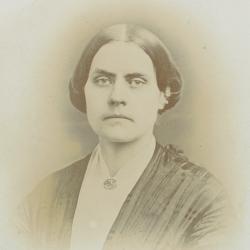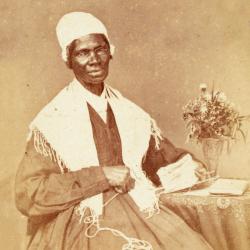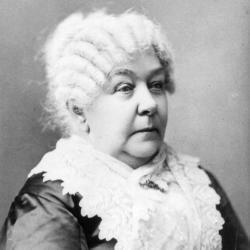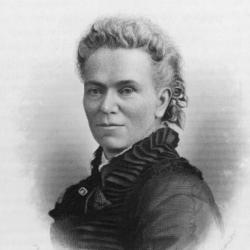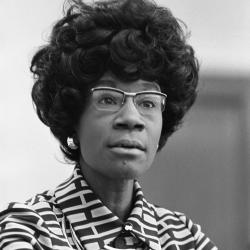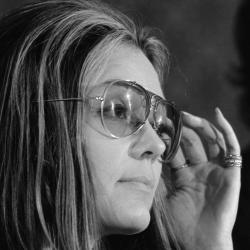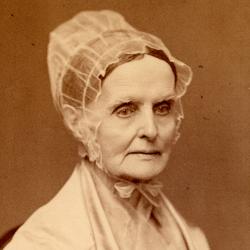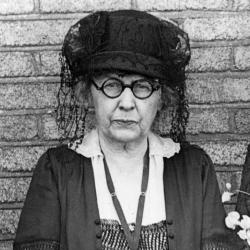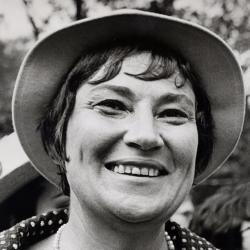Women's History Month: Notable Women in New York History
Each of these women are notable in their contributions to women's suffrage and to securing the dignity and humanity of women who have struggled in a world of prejudice and inequality. Their relentless determination and perseverance in elevating the status of women continue to make an impact in New York and throughout the world.
Susan B. Anthony (1820-1906)
Activist Speaker
Susan B. Anthony was born in 1820 in Adams, Massachusetts, to a Hicksite Quaker family. They resettled twice, first to Battenville, New York, and then to Rochester, the city Anthony called home for most of her life. The Anthony’s were involved in anti-slavery reform, hosting meetings at their farmhouse and attending conventions. Anthony also worked in the temperance movement, giving speeches on the temperance circuit.
Through her work as a teacher, Anthony quickly became aware of the wage gap between men and women in the profession. Susan’s mother, Lucy Anthony, and sister, Mary Anthony, attended the Rochester women’s right’s convention in 1848, but Susan did not attend. She became involved in women’s rights soon after meeting Elizabeth Cady Stanton in 1851, and eventually put her other reform work to the side to devote her life to the fight for women’s suffrage.
Sojourner Truth (c. 1797–1893)
Suffrage Advocate
Sojourner Truth was born into slavery as Isabella Baumfree in Ulster County, New York. In 1827, when her master failed to uphold a promise to free her, she escaped, or as she later declared, “I did not run away, I walked away by daylight.” Truth became a preacher, and choose the name by which she is known today.
Truth became active in the abolition movement, and in the 1850s, in the women’s rights movement as well. She is perhaps best known for her speech delivered to the Ohio Women’s Rights Convention of 1851, which carried the message that African American women’s rights should not be ignored.
Elizabeth Cady Stanton (1815–1902)
Women’s Rights Activist & Reformer
Elizabeth Cady Stanton first became aware of gender inequities while spending time in her father’s law office where she studied law books, debated with law clerks, and heard the plight of widows who faced losing all their property (including what they brought into the marriage). Her eyes were further opened to the world of reform in the home of her cousin, Gerrit Smith, an antislavery reformer.
In 1848, Stanton was a lead planner of the Women’s Rights Convention in Seneca Falls. She drafted the Declaration of Sentiments for the convention, which listed all the areas in which women were discriminated against—education, employment, the Church, and the law. She believed that gaining the vote was key to changing women’s status, and despite opposition from others, added the right to suffrage as one of the demands of the convention. For the rest of her life, in spite of the challenges of raising her seven children, Stanton devoted herself to writing, speaking, and organizing for women’s rights.
Matilda Joslyn Gage (1826–1898)
Editor of National Citizen and Ballot Box
Matilda Joslyn Gage entered the women’s rights movement with a speech at the 1852 National Women’s Rights Convention. Though not anticipated on the program, hers was the only speech of the convention to be reprinted in the paper, with her call to “Let Syracuse sustain her name for radicalism.”
Gage was close with her Native American neighbors, and was adopted by the Haudenosaunee into the Wolf Clan: “I received the name of Ka-ron-ien-ha-wi, or ‘Sky Carrier,’ or She who holds the sky.” While working with the Haudenosaunee, she observed a culture with a vastly different view toward women than her own. Gage and Stanton both wrote of a more equal division of power and labor in Haudenosaunee society, of women’s roles in choosing clan leaders, and of the matrilineal organization of Haudenosaunee families.
Shirley Chisholm (1924–2005)
U.S. Congresswoman
In 1968, Shirley Chisholm became the first African American woman elected to the United States Congress. Prior to this, she served as the New York State assemblywoman from Brooklyn. Her major focus was improving conditions in her community. In Congress Chisolm represented two of the poorest urban communities in the country—Bedford Stuyvesant and Crown Heights, Brooklyn, where the population was predominately black and Puerto Rican.
Chisholm publicly supported the ERA and brought the idea of women’s equality to the House floor and along with other prominent women founded the National Women’s Political Caucus in 1971. A year later, Chisholm ran for president of the United States. She campaigned across the country and succeeded in getting her name on twelve primary ballots. At the Democratic National Convention, she received 152 delegate votes, or 10 percent of the total. While she did not win any primaries, Chisholm believed that her campaign for president was a “catalyst for change.”
Gloria Steinem (1934– )
Feminist Organizer
Following study at Smith College, Gloria Steinem traveled in India, where her eyes were opened to political organizing and the importance of listening. Upon her return, she settled in New York City and began her journalism career with her “first serious assignment”: documenting the impact of the birth control pill on the social and professional lives of young women in “The Moral Disarmament of Betty Coed.”
As an activist, Steinem has dedicated her life to travel in order to give talks, to promote feminist causes, including the ERA, and to facilitate discussions amongst diverse groups. In the 1960s and 70s, she travelled to colleges, community centers, and other venues with speaking partners Dorothy Pitman Hughes, Margaret Sloan, and Florynce Kennedy.
Lucretia Mott (1793–1880)
Anti-slavery and Women’s Rights Advocate
At the 1840 World Anti-Slavery Convention in London, Lucretia Mott and other female delegates were denied the right to speak. Following this experience, Mott focused on both anti-slavery and women’s rights work for the rest of her life.
Mott, a Quaker minister, was already a respected reformer and speaker at the time of the 1848 Seneca Falls Convention—dates for the meeting were chosen to correspond with her visit to central New York, her presence lending weight to the gathering.
Although Mott lived in Philadelphia, she remained deeply involved in the movement in New York through her correspondence with her sister, Martha Coffin Wright, and friends. Mott was chosen to preside over numerous conventions, both local and national.
Harriot Stanton Blatch (1856–1940)
Founder of the Women’s Political Union (WPU)
Harriot Stanton Blatch (1856-1940) helped to revolutionize and shape New York State’s suffrage movement from a 19th century movement of upper class, white women to a modern 20th century reform movement involving women from all classes and ethnic backgrounds, except African American women.
Blatch was the second daughter and sixth child of Elizabeth Cady Stanton. Upon graduation from Vassar College in 1878, she travelled the suffrage lecture circuit with her mother and then moved to England where she met and married William Henry Blatch, Jr. While in England, she worked with women-focused reform groups and was heavily influenced by the power of the organized working classes and the militant tactics of the British suffragists.
Blatch returned to the United States in 1902 with her family and settled in New York City. She expected to jump into the suffrage movement, but was shocked to find it clinging to 19th century tactics. Blatch and a small group of women wanted to modernize the movement and soon realized that they had to abandon the traditional NYSWSA and create their own group. The result was the formation of the Equality League of Self-Supporting Women which would later become the Women’s Political Union (WPU).
Margaret Sanger (1879–1966)
Women’s Health Advocate
Working as a visiting nurse in New York City, Margaret Sanger saw the tragic circumstances of women who sought illegal and unsafe abortions, and those who remained in poverty due to rapidly growing families. She felt a call to action and “resolved that women should have knowledge of contraception. They have every right to know about their own bodies.”
In 1916, Sanger and her sister, Ethel Byrne, opened a birth control clinic in Brooklyn. Ten days later the clinic was raided, and both Sanger and Byrne served jail time. Byrne brought attention to the cause through a hunger strike in prison.
Bella Abzug (1920–1998)
Congresswoman and Activist
Bella Abzug was a longtime activist and proponent of equal rights for women. She grew up in New York City and became an attorney in the 1940s when few women entered this profession. In the 1960s, she became an anti-war activist, which led to a run for political office in New York City. In 1971, she made her first run and win for Congress on the Democratic ticket. Abzug was a huge supporter of the ERA, gay rights, and a founder of the National Women’s Political Caucus.



